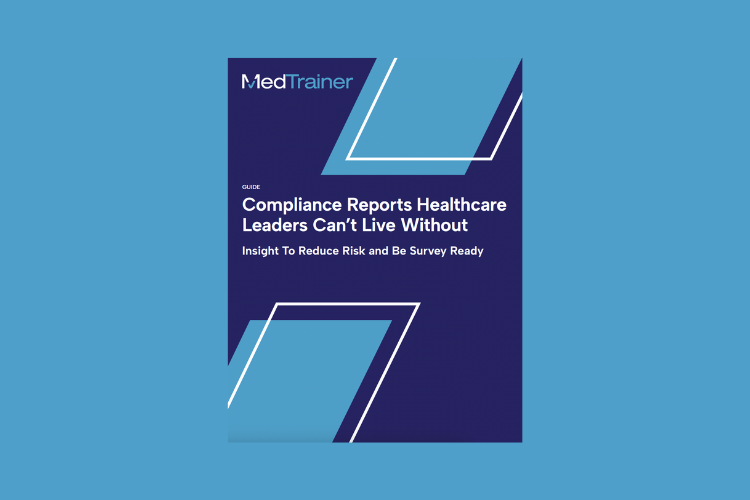The stakes are high in healthcare compliance with potential penalties, legal repercussions, and reputation damage looming over any lapses. Maintaining visibility is how leaders keep their organizations a step ahead, but that requires real-time compliance reporting to evaluate trends, anomalies, and risks.
This level of transparency is unavailable in most healthcare organizations. In fact, only 8% of executives have the visibility they need (according to a MedTrainer poll). It’s because data is kept in separate systems or, even worse, in spreadsheets or filing cabinets.
In this blog, I’ll share the most popular compliance reporting for executives and how a natively-built platform simplifies the collection and analysis of data.
What Is Healthcare Compliance Reporting?
Healthcare compliance reporting refers to the systematic documentation and submission of information that demonstrates an organization’s adherence to regulatory requirements and standards. This process involves collecting, managing, and analyzing data related to healthcare operations, such as staff training, credentialing, policy acknowledgments, and incident reporting.
Compliance reports offer the high-level view that executives need to make business decisions, evaluate risks, and improve organizational efficiency. They’re also critical in proving to regulators, accrediting agencies, and your governing board that the organization meets all necessary legal and ethical standards.
Why Digital Compliance Reporting Is Vital
In most healthcare organizations, compliance reporting involves some sort of manual tracking or spreadsheet consolidation, which means delays, unintentional errors, and often incomplete data. It’s not the reporting that an executive wants to rely on.
Using a digital solution, you have access to real-time data along with the ability to schedule reports to automatically send to either internal or external recipients. Customizable reports make it possible to get exactly the information you need and dashboards off at-a-glance data. With all your information in an all-in-one compliance platform, it’s easy to identify trends in one location, make sure exclusions monitoring is ongoing, and confirm board approval on all policies.
Compliance Reporting That Every Executive Needs
Executives who stay on top of high-level data on a regular basis are more prepared for an audit or inspection. There aren’t surprises that pop up 30 or 60 days out and you have increased confidence in your team. If you aren’t seeing compliance reporting consistently, start asking for it now. If you don’t have a compliance software in place, this request could be a big ask (it might be time to make a switch!).
Incident Report Trends
Analyzing healthcare incident report data makes you aware of the organization’s biggest risks and helps to identify trends before they become a serious problem. Many executives want to see resolved incidents by month and location. Another common compliance report is escalated incidents by elapsed time and escalation process to see where resolution is being delayed. As the organization’s leader, you can step in to help your compliance team when a potential problem is detected and reinforce the importance of education and prevention.
Training Completion
Seeing the training completion percentages by role, department, and location can be a great indicator for executives. Lower completion could mean you have more incidents in these areas or that employees are less engaged and more likely to leave. With staff turnover in healthcare still a big problem, these signs could be critical. Using this type of compliance reporting, you can step in and ask these employees to complete the required education — nothing prompts action like a direct request!
Policy Acknowledgment
Similar to training completion reports, seeing that many employees have not reviewed policies can indicate more incidents or frustration from their peers when they don’t know the proper procedures. It could also indicate a problem in your new hire onboarding process, since most healthcare policies need to be acknowledged by new employees.
Payer Enrollment
Visibility into the organization’s credentialing and enrollment processes are critical to keep revenue moving. When credentialers complete all actions within a credentialing platform, there is an incredible amount of data that can offer insight and help with process improvement. For example, using capacity data, you can determine if your current staff can keep up or if you need to hire temporary staff for the credentialing busy season. Submittal data can tell you how quickly payers are responding to applications and also how long it takes your team to submit. Use a credentialing platform with enhanced credentialing reporting and dashboards for the visibility you need.

The best compliance and credentialing reports tot surface critical insights and keep you survey ready.
Make It Easy With a Healthcare Compliance Platform
All-in-one compliance platforms, such as MedTrainer, bring together all compliance and credentialing data to provide insight and analysis that you can’t get from spreadsheets or combining data from multiple point solutions.
Healthcare executives love the customizable compliance reporting that makes it possible to have reports designed for audits, reports for board meetings, and just weekly status updates. Real-time dashboards offer a view of your organization’s most important credentialing metrics to keep revenue and provider availability on track.
Plus, a compliance platform increases the efficiency of all staff. Your compliance and HR teams are no longer manually sorting or tracking data and all employees have online access to polices, procedures, documents, and training.
